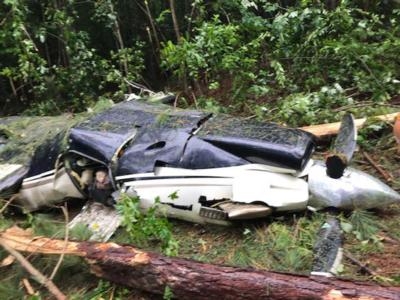Finds Pilot Flying The Airplane In IFR Conditions Was Not Instrument Rated
The NTSB has released a preliminary report from an accident which occurred June 7 near Castalia, North Carolina which fatally injured all four people aboard the aircraft.

According to the report, at about 1333 eastern daylight time, the Piper PA 46-350P, N709CH, broke up in flight following an encounter with weather near Castalia, North Carolina. The private pilot, a pilot-rated passenger, and two other passengers were fatally injured. The airplane was destroyed. The airplane was registered to the pilot. Day, instrument meteorological conditions prevailed in the area, and an instrument flight rules flight plan was filed for the flight. The flight originated at Naples, Florida (KAPF) and was destined for Easton Airport (KESN), Easton, Maryland.
According to preliminary air traffic control radar and voice communication information from the FAA, the flight was on a northeasterly ground track at flight level (FL) 270 over eastern North Carolina when the pilot reported that there was weather ahead on his radar. After discussing the weather with the controller and reviewing options, the flight was eventually cleared direct to the Franklin VOR. About two minutes prior to the accident, the pilot reported that they were entering an area of rain. The airplane was then observed climbing to FL273, followed by a rapidly descending right turn and loss of radio and radar contact. The controller made numerous attempts to contact the pilot, to no avail. A postaccident review of recorded weather radar data indicated that the airplane was in the vicinity of heavy rain and thunderstorms at the time of the accident.
The airplane impacted wooded terrain about 4 miles northeast of the town of Castalia. The outboard sections of the wings and a section of the elevator were found about 1.4 miles northeast of the main wreckage. Several components of the empennage have not been located due to the dense forest in the area. The main wreckage consisted of the entire fuselage and the inboard sections of the wings. The fuselage was found inverted on a heading of 045°. There was no fire.
The pilot, seated in the left cockpit seat, was also the registered owner and operator of the airplane. He held a private pilot certificate with an airplane single-engine land rating. He did not hold an instrument rating. A review of his pilot logbook revealed that he had logged about 312 hours total flight time, including 147 hours in the accident airplane. His latest flight review was recorded on October 3, 2017.
The pilot-rated passenger, seated in the right cockpit seat, held a private pilot certificate with an airplane single-engine land rating. He held an instrument rating. A review of his pilot logbook revealed that he had logged about 1,062 hours total flight time, including 173 hours in the accident airplane. His most recent flight review was recorded on April 14, 2017. He had not logged any actual instrument time or instrument approaches during the 12 months prior to the accident.
Media reports indicate that there were also two dogs on board the airplane, which did not survive the accident.
The low wing, retractable tricycle landing gear airplane was manufactured in 2007. In 2017, the original reciprocating engine was removed and a Pratt and Whitney PT6A-35 turboprop engine was installed per a JetProp LLC supplemental type certificate. An annual inspection was completed on April 29, 2019. The total time on the airframe at the time of the accident was 1,449 hours and the engine had accumulated 226 hours time in service since new.
(Source NTSB. Image provided by the Nash County, NC Sheriff's Office via Facebook)
 ANN's Daily Aero-Term (05.01.24): Say Altitude
ANN's Daily Aero-Term (05.01.24): Say Altitude ANN's Daily Aero-Linx (05.01.24)
ANN's Daily Aero-Linx (05.01.24) Classic Aero-TV: Korean War Hero Twice Reborn
Classic Aero-TV: Korean War Hero Twice Reborn Airborne 04.29.24: EAA B-25 Rides, Textron 2024, G700 Deliveries
Airborne 04.29.24: EAA B-25 Rides, Textron 2024, G700 Deliveries Airborne Affordable Flyers 05.02.24: Bobby Bailey, SPRG Report Cards, Skydive!
Airborne Affordable Flyers 05.02.24: Bobby Bailey, SPRG Report Cards, Skydive!



